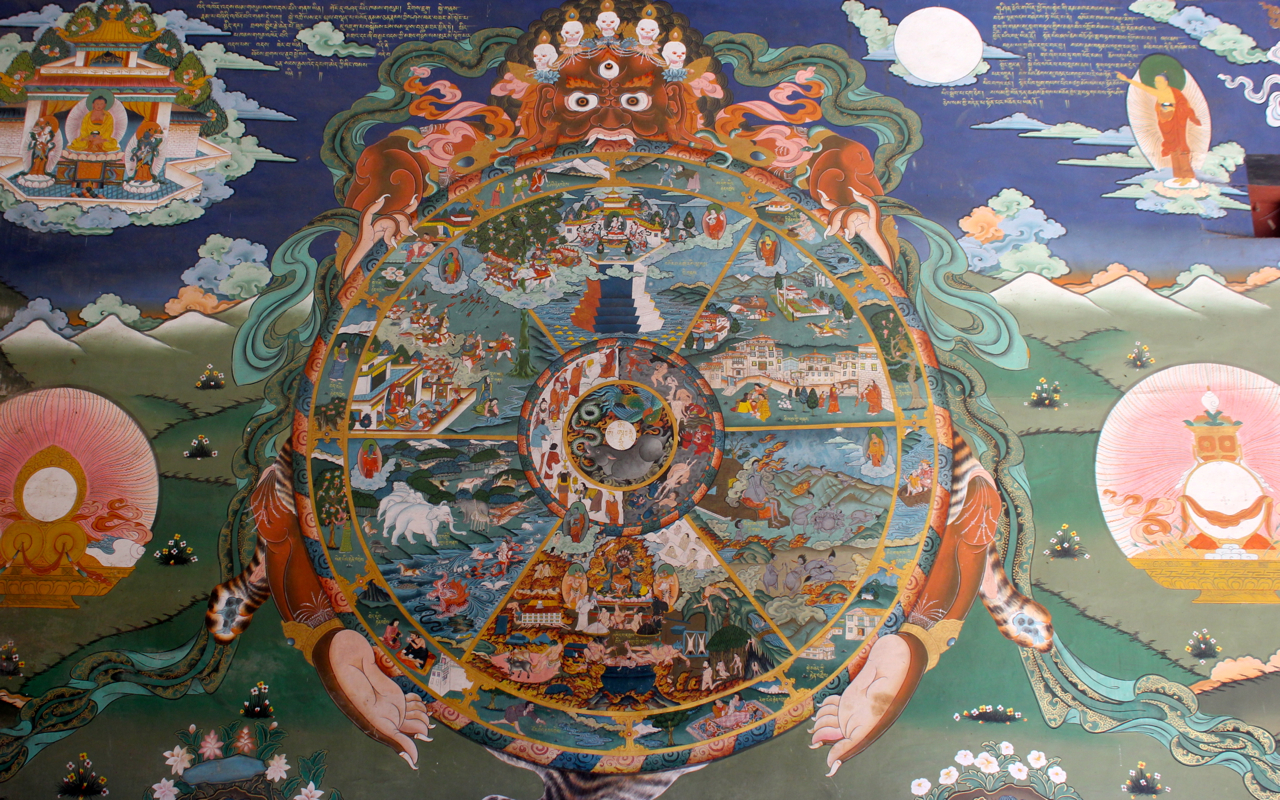|
Akṣayamatinirdeśa Sūtra
The ''Akṣayamatinirdeśa'' (Skt, Exposition of Akṣayamati, Tibetan: ''Blo gros mi zad pas bstan pa''; Chinese: ''Wujinyi pusa pin / Achamo pusa jing'', 無盡意菩薩品 / 阿差末菩薩經) is a Mahāyāna sūtra which teaches the doctrine of imperishability (''akṣayatā'') and the eighty different aspects of the Dharma which are imperishable (which constitute the whole bodhisattva path).Buswell Jr., Robert E.; Lopez Jr., Donald S. (2013). ''The Princeton Dictionary of Buddhism,'' pp. 27. Princeton University Press.Braarvig (1993), vol. I, p. vii. According to Jens Braarvig, the sutra may have reached a definite form sometime in the second century CE. The ''Akṣayamatinirdeśa'' is a part of the Mahāsannipāta Collection of Mahāyāna sutras and it is closely related to the '' Bodhisattvapiṭaka sutra.''Pagel, Ulrich (1994). The Bodhisattvapiṭaka and Akṣayamatinirdeśa: Continuity and Change in Buddhist Sūtras'' The Buddhist Forum Volume v.3 Pages 333 - 37 ... [...More Info...] [...Related Items...] OR: [Wikipedia] [Google] [Baidu] |
Akṣayamati
Akṣayamati ( sa, अक्षयमति; also called Inexhaustible Awareness) is a bodhisattva who appears in the Lotus Sutra and the Akṣayamatinirdeśa Sūtra within the larger Mahāvaipulya Mahāsamghāta Sūtra. He is recognized as one of the sixteen bodhisattvas of the auspicious aeon (''bhadrakalpa''). He also has the ability to perceive and understand all actions of cause and effect (Skt. aparuṣā). Lotus Sutra In Chapter 25 of the Lotus Sutra, Akṣayamati asks the Buddha to elaborate on the character of the bodhisattva Avalokiteśvara. After receiving a detailed explanation on the Bodhisattva's wanderings throughout the world, Akṣayamati offers Avalokiteśvara a pearl necklace of great value. Avalokiteśvara refuses at first, but Akṣayamati entreats him to accept it for the Dharma, out of compassion. Avalokiteśvara finally accepts the necklace out of compassion for the fourfold assembly, devas, nāgas, yakshas, gandharvas, asuras, garudas, kinnaras, maho ... [...More Info...] [...Related Items...] OR: [Wikipedia] [Google] [Baidu] |
Abhijñā
Abhijñā ( sa, अभिज्ञा; Pali pronunciation: ''abhiññā''; bo, མངོན་ཤེས ''mngon shes''; ) is a Buddhist term generally translated as "direct knowledge", "higher knowledge"Rhys Davids & Stede (1921-5), pp. 64-65. or "supernormal knowledge." In Buddhism, such special knowledge is obtained through virtuous living and meditation. The attainment of the four jhanas, or meditative absorptions, are considered a prerequisite for their attainment. In terms of specifically enumerated knowledges, these include mundane extra-sensory abilities (such as seeing past lives and various supranormal powers like levitation) as well as the supramundane, meaning the extinction of all mental intoxicants (''āsava''). Pali literature In Pali literature, ''abhiññā'' refers to both the direct apprehension of ''dhamma'' (translated below as "states" and "qualities") as well as to specialized super-normal capabilities. Direct knowing of ''dhamma'' In SN 45.159, the B ... [...More Info...] [...Related Items...] OR: [Wikipedia] [Google] [Baidu] |
śūnyatā
''Śūnyatā'' ( sa, शून्यता, śūnyatā; pi, suññatā; ), translated most often as ''emptiness'', ''vacuity'', and sometimes ''voidness'', is an Indian philosophical concept. Within Hinduism, Jainism, Buddhism and other philosophical strands, the concept has multiple meanings depending on its doctrinal context. It is either an ontological feature of reality, a meditative state, or a phenomenological analysis of experience. In Theravāda Buddhism, ''Suññatā'' often refers to the non-self (Pāli: ''anattā'', Sanskrit: ''anātman'') nature of the five aggregates of experience and the six sense spheres. ''Suññatā'' is also often used to refer to a meditative state or experience. In Mahāyāna Buddhism, ''śūnyatā'' refers to the tenet that "all things are empty of intrinsic existence and nature ('' svabhava'')", but may also refer to the Buddha-nature teachings and primordial or empty awareness, as in Dzogchen, Shentong, or Chan. Etymology " ... [...More Info...] [...Related Items...] OR: [Wikipedia] [Google] [Baidu] |
Buddhist Hermeneutics
Buddhist hermeneutics refers to the interpretative frameworks historical Buddhists have used to interpret and understand Buddhist texts and to the interpretative instructions that Buddhists texts themselves impart upon the reader. Because of the broad variety of scriptures, Buddhist traditions and schools, there are also a wide variety of different hermeneutic approaches within Buddhism. Buddhist scriptural exegesis has always been driven by the soteriological needs of the tradition to find the true meaning (''artha'') of Buddhist scriptures. Another important issue in Buddhist hermeneutics is the problem of which sutras are to be taken to be ' Buddhavacana', "the word of the Buddha" and also which sutras contain the correct teachings. The Early Buddhist texts such as the Sutta Pitaka and the Agamas distinguish between Buddhist suttas that contain clear meaning (Pāli:Nītattha; Sanskrit: nītārtha) and those that require further interpretation (Pāli: neyyattha; Sanskrit: neya ... [...More Info...] [...Related Items...] OR: [Wikipedia] [Google] [Baidu] |
Sthiramati
Sthiramati (Sanskrit; Chinese:安慧; Tibetan: ''blo gros brtan pa'') or Sāramati was a 6th-century Indian Buddhist scholar-monk. Sthiramati was a contemporary of Dharmapala based primarily in Valābhi university (present-day Gujarat), although he is thought to have spent some time at Nālandā. He was renowned for his numerous and detailed commentaries on Yogācāra and Abhidharma, works by Vasubandhu and others, as well as for a commentary on the '' Kaśyāpa-parivarta''. He was a student of the Valābhi Yogacara scholar Gunamati. Takasaki is certain that the author of the embedded commentary (verse and prose) to the core text (verse) of the ''Ratnagotravibhāga'' GV version as per Johnston GV or gv may refer to: Businesses and organizations * GV (company), formerly Google Ventures * Aero Flight (IATA airline designator) * Globovisión, a Venezuelan news network * Golden Village, a movie theater chain in Singapore * Grand Valley ...is Sāramati through his analysis ... [...More Info...] [...Related Items...] OR: [Wikipedia] [Google] [Baidu] |
Vasubandhu
Vasubandhu (; Tibetan: དབྱིག་གཉེན་ ; fl. 4th to 5th century CE) was an influential Buddhist monk and scholar from ''Puruṣapura'' in ancient India, modern day Peshawar, Pakistan. He was a philosopher who wrote commentary on the Abhidharma, from the perspectives of the Sarvastivada and Sautrāntika schools. After his conversion to Mahayana Buddhism, along with his half-brother, Asanga, he was also one of the main founders of the Yogacara school. Vasubandhu's '' Abhidharmakośakārikā'' ("Commentary on the Treasury of the Abhidharma") is widely used in Tibetan and East Asian Buddhism, as the major source for non-Mahayana Abhidharma philosophy. His philosophical verse works set forth the standard for the Indian Yogacara metaphysics of "appearance only" (''vijñapti-mātra''), which has been described as a form of " epistemological idealism", phenomenology and close to Immanuel Kant's transcendental idealism. Apart from this, he wrote several commentar ... [...More Info...] [...Related Items...] OR: [Wikipedia] [Google] [Baidu] |
Yogachara
Yogachara ( sa, योगाचार, IAST: '; literally "yoga practice"; "one whose practice is yoga") is an influential tradition of Buddhist philosophy and psychology emphasizing the study of cognition, perception, and consciousness through the interior lens of meditative and yogic practices. It is also variously termed ''Vijñānavāda'' (the doctrine of consciousness), ''Vijñaptivāda'' (the doctrine of ideas or percepts) or ''Vijñaptimātratā-vāda'' (the doctrine of 'mere representation'), which is also the name given to its major epistemic theory. There are several interpretations of this main theory; while often regarded as a kind of Idealism, critical scholars argue that it is closer to a kind of phenomenology or representationalism, aimed at deconstructing the reification of our perceptions. According to Dan Lusthaus, this tradition developed "an elaborate psychological therapeutic system that mapped out the problems in cognition along with the antidotes to cor ... [...More Info...] [...Related Items...] OR: [Wikipedia] [Google] [Baidu] |
Vimalakirti Sutra
The ''Vimalakīrti Nirdeśa'' (Devanagari: विमलकीर्तिनिर्देश) (sometimes referred to as the ''Vimalakīrti Sūtra'' or ''Vimalakīrti Nirdeśa Sūtra'') is a Buddhist text which centers on a lay Buddhist meditator who attained a very high degree of enlightenment considered by some second only to the Buddha's. It was extremely influential in East Asia, but most likely of considerably less importance in the Indian and Tibetan sub-traditions of Mahāyāna Buddhism. The word ''nirdeśa'' in the title means "instruction, advice", and Vimalakīrti is the name of the main protagonist of the text, and means "Taintless Fame". The sutra teaches, among other subjects, the meaning of nondualism, the doctrine of the true body of the Buddha, the characteristically Mahāyāna claim that the appearances of the world are mere illusions, and the superiority of the Mahāyāna over other paths. It places in the mouth of the upāsaka (lay practitioner) Vimalakīrti a ... [...More Info...] [...Related Items...] OR: [Wikipedia] [Google] [Baidu] |
Locus Classicus
{{Short pages monitor ... [...More Info...] [...Related Items...] OR: [Wikipedia] [Google] [Baidu] |
Yogachara
Yogachara ( sa, योगाचार, IAST: '; literally "yoga practice"; "one whose practice is yoga") is an influential tradition of Buddhist philosophy and psychology emphasizing the study of cognition, perception, and consciousness through the interior lens of meditative and yogic practices. It is also variously termed ''Vijñānavāda'' (the doctrine of consciousness), ''Vijñaptivāda'' (the doctrine of ideas or percepts) or ''Vijñaptimātratā-vāda'' (the doctrine of 'mere representation'), which is also the name given to its major epistemic theory. There are several interpretations of this main theory; while often regarded as a kind of Idealism, critical scholars argue that it is closer to a kind of phenomenology or representationalism, aimed at deconstructing the reification of our perceptions. According to Dan Lusthaus, this tradition developed "an elaborate psychological therapeutic system that mapped out the problems in cognition along with the antidotes to cor ... [...More Info...] [...Related Items...] OR: [Wikipedia] [Google] [Baidu] |
Madhyamaka
Mādhyamaka ("middle way" or "centrism"; ; Tibetan: དབུ་མ་པ ; ''dbu ma pa''), otherwise known as Śūnyavāda ("the emptiness doctrine") and Niḥsvabhāvavāda ("the no ''svabhāva'' doctrine"), refers to a tradition of Buddhist philosophy and practice founded by the Indian Buddhist monk and philosopher Nāgārjuna (c. 150 – c. 250 CE).Wynne, Alexander (2015) ''Early Buddhist Teaching as Proto-śūnyavāda.'' Journal of the Oxford Centre for Buddhist Studies, 6. pp. 213-241. The foundational text of the Mādhyamaka tradition is Nāgārjuna's '' Mūlamadhyamakakārikā'' ("Root Verses on the Middle Way"). More broadly, Mādhyamaka also refers to the ultimate nature of phenomena as well as the non-conceptual realization of ultimate reality that is experienced in meditation. Mādhyamaka thought had a major influence on the subsequent development of the Mahāyāna Buddhist tradition. It is the dominant interpretation of Buddhist philosophy in Tibetan Buddhis ... [...More Info...] [...Related Items...] OR: [Wikipedia] [Google] [Baidu] |
Saṃsāra
''Saṃsāra'' (Devanagari: संसार) is a Pali/Sanskrit word that means "world". It is also the concept of rebirth and "cyclicality of all life, matter, existence", a fundamental belief of most Indian religions. Popularly, it is the cycle of death and Reincarnation, rebirth. ''Saṃsāra'' is sometimes referred to with terms or phrases such as Transmigration of the soul, transmigration/reincarnation, Karma, karmic cycle, or Punarjanman, and "cycle of aimless drifting, wandering or mundane existence". The concept of ''saṃsāra'' has roots in the post-Vedas, Vedic literature; the theory is not discussed in the Vedas themselves. It appears in developed form, but without mechanistic details, in the early Upanishads. The full exposition of the ''saṃsāra'' doctrine is found in Sramana, Śramaṇic movements such as Pre-sectarian Buddhism, early Buddhism and Jainism, as well as various schools of Hindu philosophy after about the mid-1st millennium BCE. The ''saṃsāra'' ... [...More Info...] [...Related Items...] OR: [Wikipedia] [Google] [Baidu] |

.jpg)






